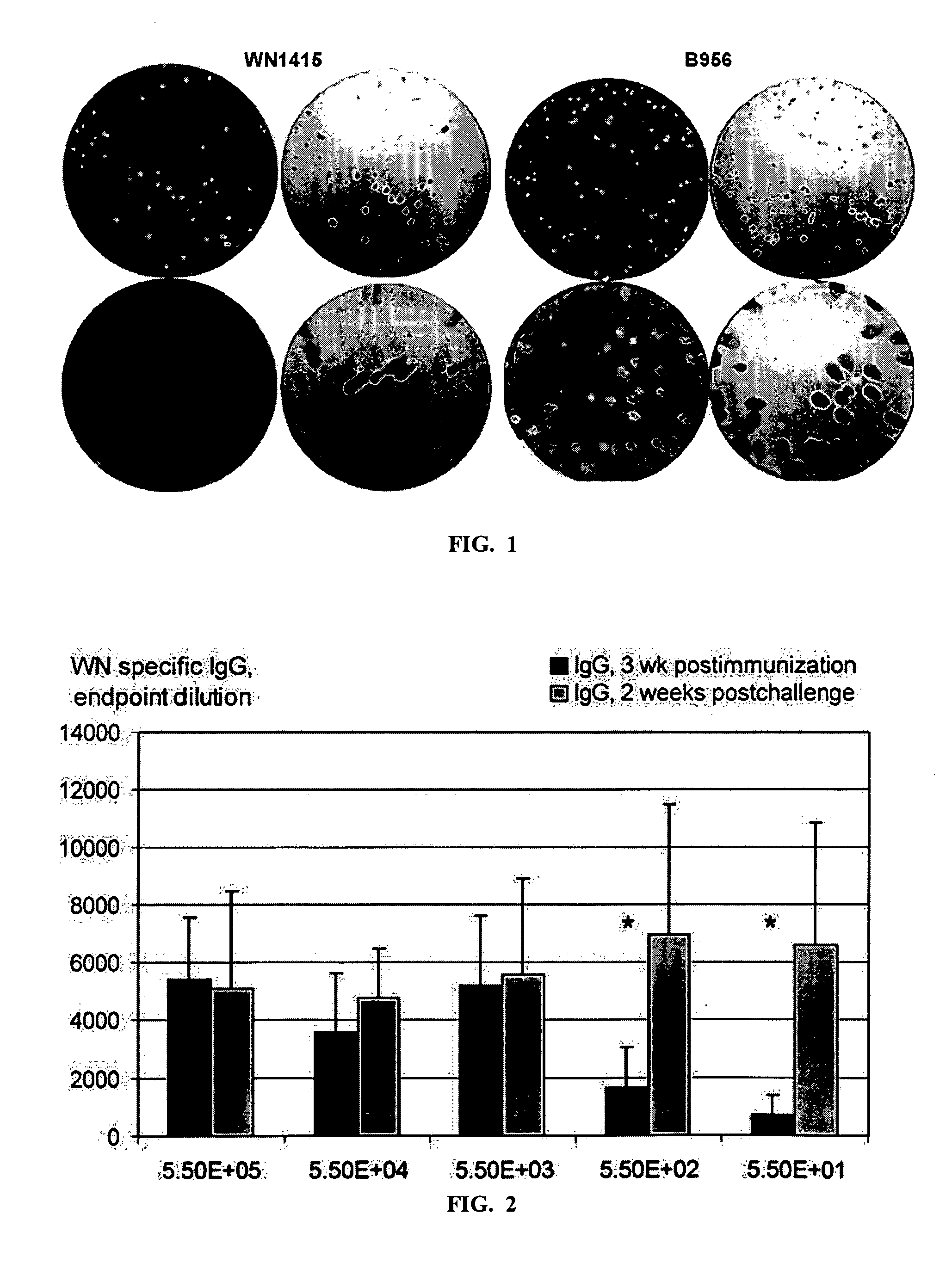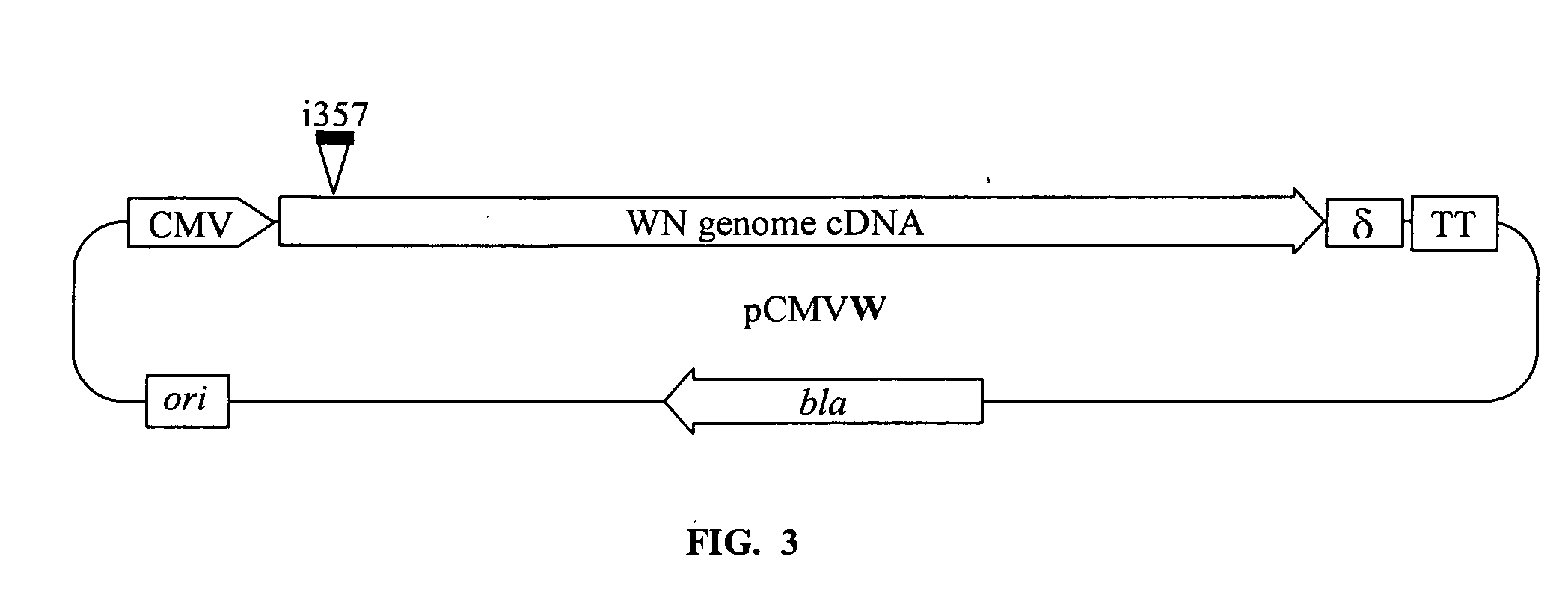Infectious DNA as a vaccine against west nile and other flavivirues
a technology of infectious dna and vaccine, which is applied in the field of infectious dna as a vaccine against west nile and other flavivirues, can solve the problems of affecting the development affecting the ability of live attenuated west nile vaccine to elicit balanced humoral and cell-mediated immune responses, and imposing a substantial economic burden. , to achieve the effect of reducing the risk of infection,
- Summary
- Abstract
- Description
- Claims
- Application Information
AI Technical Summary
Benefits of technology
Problems solved by technology
Method used
Image
Examples
example 1
Preparation of Infectious Clone of West Nile Virus
[0040] This example is set forth in Yamshchikov, An Infectious Clone of the West Nile Flavivirus, 1: Virology. 2001 Mar. 15;281(2):294-304, which is incorporated by reference in its entirety.
[0041] Cell Culture and Viruses
[0042] BHK-21 (Bredenbeek et al., 1993) and Vero (ATCC CRL-1586) cells were maintained at 37° C. in humidified atmosphere containing 5% CO2 in Dulbecco's modified Eagle medium (“DMEM”) supplemented with 5% fetal calf serum (“FCS”, Hyclone) and 13 antibiotic±antimycotic mixture (GIBCO-BRL). Aedes albopictus clone C6 / 36 (ATCC CRL-1660) cells were maintained at 28° C. in the same media supplemented with 10% FCS. The WN strain having ATCC Deposit No. ______ used in this study was recovered after electroporation of BHK cells with archival RNA isolated from virus WN956D1173B, which had been triply plaque-purified in Vero cells and grown in BHK cells (Wengler and Gross, 1978). The previous passage history of this virus ...
example 2
Isolation of WN 1415, a Molecular Clone of the 956D117B3 Virus
[0046] Isolate WN1415 used in this example was recovered after transfection of synthetic RNA prepared from the pSP6WN / Xba infectious clone (Yamshchikov et al., 2001) into BHK cells and was used at passage 2 in Vero cells.
[0047] For genetic characterization, total RNA was isolated from Vero cells infected with WN1415 at passage 2 after transfection. Direct sequencing of gel-purified cDNA fragments prepared from this RNA has revealed two silent substitutions in positions 4566 (C) and 8355 (U) of the WN1415 genome as compared to the reported nucleotide sequence of 956D117B3 (GenBank #M12294, which is incorporated by reference). No other differences were identified. The above substitutions, which are present in the infectious clone plasmid pWN14115 as well, likely constitute cDNA variants selected during cloning.
[0048] The nucleotide sequence of the parent 956D117B3 isolate at Vero passage 2 after its rescue from archival ...
example 3
Sequence Analysis of Parent B956 and its Descendants
[0049] This example investigated the extent of changes accumulated in the 956B117D3 genome over its passage history. In this example, the original B956 strain at mouse brain passage 2 was obtained from Dr. R. Shope (Galveston, Tex.). The B956 virus was passaged once in C6 / 36 cells and total RNA isolated from virus-infected cells was used for preparation of purified cDNA fragments.
[0050] Consensus sequencing (Pugachev et al., 2002) was done after reverse transcriptase polymerase chain reaction (“RT-PCR”) amplification of eight overlapping cDNA fragments spanning the entire genome of WN1415, 956D117B3 or B956 viruses using taq polymerase (Novagen). The gel-purified fragments were sequenced without intermediate subcloning steps using the ABI310 Genetic Analyzer (ABI, Foster City, Calif.). A set of sequencing primers was designed to provide overlapping sequence segments covering the entire genome in both directions based on GenBank #...
PUM
| Property | Measurement | Unit |
|---|---|---|
| Fraction | aaaaa | aaaaa |
| Fraction | aaaaa | aaaaa |
| Fraction | aaaaa | aaaaa |
Abstract
Description
Claims
Application Information
 Login to View More
Login to View More - R&D
- Intellectual Property
- Life Sciences
- Materials
- Tech Scout
- Unparalleled Data Quality
- Higher Quality Content
- 60% Fewer Hallucinations
Browse by: Latest US Patents, China's latest patents, Technical Efficacy Thesaurus, Application Domain, Technology Topic, Popular Technical Reports.
© 2025 PatSnap. All rights reserved.Legal|Privacy policy|Modern Slavery Act Transparency Statement|Sitemap|About US| Contact US: help@patsnap.com


